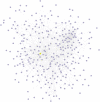CDK-dependent Hsp70 Phosphorylation controls G1 cyclin abundance and cell-cycle progression
- PMID: 23217712
- PMCID: PMC3778871
- DOI: 10.1016/j.cell.2012.10.051
CDK-dependent Hsp70 Phosphorylation controls G1 cyclin abundance and cell-cycle progression
Abstract
In budding yeast, the essential functions of Hsp70 chaperones Ssa1-4 are regulated through expression level, isoform specificity, and cochaperone activity. Suggesting a novel regulatory paradigm, we find that phosphorylation of Ssa1 T36 within a cyclin-dependent kinase (CDK) consensus site conserved among Hsp70 proteins alters cochaperone and client interactions. T36 phosphorylation triggers displacement of Ydj1, allowing Ssa1 to bind the G1 cyclin Cln3 and promote its degradation. The stress CDK Pho85 phosphorylates T36 upon nitrogen starvation or pheromone stimulation, destabilizing Cln3 to delay onset of S phase. In turn, the mitotic CDK Cdk1 phosphorylates T36 to block Cln3 accumulation in G2/M. Suggesting broad conservation from yeast to human, CDK-dependent phosphorylation of Hsc70 T38 similarly regulates Cyclin D1 binding and stability. These results establish an active role for Hsp70 chaperones as signal transducers mediating growth control of G1 cyclin abundance and activity.
Copyright © 2012 Elsevier Inc. All rights reserved.
Figures














Similar articles
-
Growth-Regulated Hsp70 Phosphorylation Regulates Stress Responses and Prion Maintenance.Mol Cell Biol. 2020 May 28;40(12):e00628-19. doi: 10.1128/MCB.00628-19. Print 2020 May 28. Mol Cell Biol. 2020. PMID: 32205407 Free PMC article.
-
Cyclin Cln3 is retained at the ER and released by the J chaperone Ydj1 in late G1 to trigger cell cycle entry.Mol Cell. 2007 Jun 8;26(5):649-62. doi: 10.1016/j.molcel.2007.04.023. Mol Cell. 2007. PMID: 17560371
-
Ydj1 interaction at nucleotide-binding-domain of yeast Ssa1 impacts Hsp90 collaboration and client maturation.PLoS Genet. 2022 Nov 9;18(11):e1010442. doi: 10.1371/journal.pgen.1010442. eCollection 2022 Nov. PLoS Genet. 2022. PMID: 36350833 Free PMC article.
-
[Molecular mechanisms controlling the cell cycle: fundamental aspects and implications for oncology].Cancer Radiother. 2001 Apr;5(2):109-29. doi: 10.1016/s1278-3218(01)00087-7. Cancer Radiother. 2001. PMID: 11355576 Review. French.
-
Pho85, a multifunctional cyclin-dependent protein kinase in budding yeast.Mol Microbiol. 2007 Oct;66(2):303-14. doi: 10.1111/j.1365-2958.2007.05914.x. Epub 2007 Sep 10. Mol Microbiol. 2007. PMID: 17850263 Review.
Cited by
-
c-Abl Mediated Tyrosine Phosphorylation of Aha1 Activates Its Co-chaperone Function in Cancer Cells.Cell Rep. 2015 Aug 11;12(6):1006-18. doi: 10.1016/j.celrep.2015.07.004. Epub 2015 Jul 30. Cell Rep. 2015. PMID: 26235616 Free PMC article.
-
Decrypting the chaperone code.J Biol Chem. 2021 Jan-Jun;296:100293. doi: 10.1016/j.jbc.2021.100293. Epub 2021 Feb 16. J Biol Chem. 2021. PMID: 33837727 Free PMC article. No abstract available.
-
Novel insights into the post-translational modifications of Ydj1/DNAJA1 co-chaperones.Cell Stress Chaperones. 2024 Feb;29(1):1-9. doi: 10.1016/j.cstres.2023.11.001. Epub 2023 Nov 17. Cell Stress Chaperones. 2024. PMID: 38309209 Free PMC article. Review.
-
Cellular sequestrases maintain basal Hsp70 capacity ensuring balanced proteostasis.Nat Commun. 2019 Oct 24;10(1):4851. doi: 10.1038/s41467-019-12868-1. Nat Commun. 2019. PMID: 31649258 Free PMC article.
-
Chaperones directly and efficiently disperse stress-triggered biomolecular condensates.Mol Cell. 2022 Feb 17;82(4):741-755.e11. doi: 10.1016/j.molcel.2022.01.005. Epub 2022 Feb 10. Mol Cell. 2022. PMID: 35148816 Free PMC article.
References
-
- Bishop A.C., Ubersax J.A., Petsch D.T., Matheos D.P., Gray N.S., Blethrow J., Shimizu E., Tsien J.Z., Schultz P.G., Rose M.D. A chemical switch for inhibitor-sensitive alleles of any protein kinase. Nature. 2000;407:395–401. - PubMed
Supplemental References
-
- Bishop, A.C., Ubersax, J.A., Petsch, D.T., Matheos, D.P., Gray, N.S., Blethrow, J., Shimizu, E., Tsien, J.Z., Schultz, P.G., Rose, M.D., et al. (2000). A chemical switch for inhibitor-sensitive alleles of any protein kinase. Nature 407, 395–401. - PubMed
-
- Costanzo, M., Nishikawa, J.L., Tang, X., Millman, J.S., Schub, O., Breitkreuz, K., Dewar, D., Rupes, I., Andrews, B., and Tyers, M. (2004). CDK activity antagonizes Whi5, an inhibitor of G1/S transcription in yeast. Cell 117, 899–913. - PubMed
-
- Goldstein, A.L., and McCusker, J.H. (1999). Three new dominant drug resistance cassettes for gene disruption in Saccharomyces cerevisiae. Yeast 15, 1541–1553. - PubMed
Publication types
MeSH terms
Substances
Grants and funding
LinkOut - more resources
Full Text Sources
Other Literature Sources
Molecular Biology Databases
Research Materials
Miscellaneous

